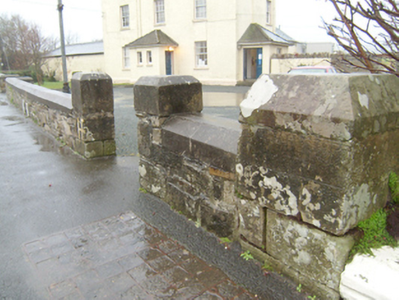Survey Data
Reg No
40807012
Rating
Regional
Categories of Special Interest
Architectural, Historical, Social
Original Use
RIC barracks
In Use As
Garda station/constabulary barracks
Date
1860 - 1880
Coordinates
201675, 437312
Date Recorded
18/11/2010
Date Updated
--/--/--
Description
Detached three-bay three-storey former Royal Irish Constabulary barracks, built c. 1870, having single-bay single-storey entrance porch to the centre of the main elevation (south), single-bay single-storey entrance porch to the east elevation, , and with single-storey block to the west. Now in use as a Garda Station. Replacement hipped artificial slate roof with projecting rendered eaves course, cast-iron rainwater goods with three stepped two-stage rendered chimneystacks (on to either end and one to the rear pitch). Hipped artificial roofs to porch and single-storey blocks. Roughcast rendered walls over projecting smooth rendered plinth course. Square-headed windows openings having painted stone sills, smooth rendered reveals, and with six-over-six pane timber sliding sash windows at ground and first floor level with six-over-three pane timber sliding sash windows at second floor level. Square-headed window openings to the south elevation of central porch having one-over-one pane timber sliding sash windows. Square-headed doorways to the east elevation of front porch, and to the south elevation of later porch to the east elevation, having replacement timber doors. Set back from road to the west end of the Main Street, Dunfanaghy. Coursed and squared rubble stone boundary wall to the south having chamfered ashlar(?) and smooth rendered coping over. Gateways to site having squared and coursed rubble stone gate piers (on square-plan) with chamfered coping over. Gravel forecourt to the south-east of site. Modern radio mast to the north. Rendered and rubble stone walls to the east and north-east.
Appraisal
This imposing and classically-proportioned three-storey building, dating to the second half of the nineteenth century, retains its early form and character despite some limited modern alterations. Its visual appeal is enhanced by the retention of salient fabric such as the timber sliding sash windows. It is of social and historical interest to the local area as a purpose-built Royal Irish Constabulary barracks, and it follows a standard three-bay three-storey form that can be found in similar buildings in Ireland. It occupies a prominent location ion the streetscape to the west end of the Main Street, Dunfanaghy, at the junction of the two main approach roads into the village from the west and the south (N56). It remains in its original function as police station having been in use as a Garda Station since c. 1925. It replaced earlier constabulary barracks at Dunfanaghy that were located to the east along the south side of Main Street in 1836 (Ordnance Survey first edition six-inch maps) and a later barracks that lay adjacent to the south of the present site in c. 1860 (Griffith’s Valuation map). Its scale suggests that it may have been originally a district headquarters etc. A Mason Alcock was the sub-inspector here in 1881 with a Park Dee(?) the head constable in 1881, and a H. O’H Hill(?) the district inspector and an I. Thompson the head constable in 1894 (both Slater’s Directory). There were nine policemen stationed here at the time of the 1911 Census, with a Lawrence Finnegan the head constable at the time with additional two sergeants and six constables stationed here at this time. This building is a landmark structure to the west end of Dunfanaghy, and is an element of the built heritage of the town. The simple outbuildings and rubble stone boundary walls to site add to the setting and context, and complete this composition.







